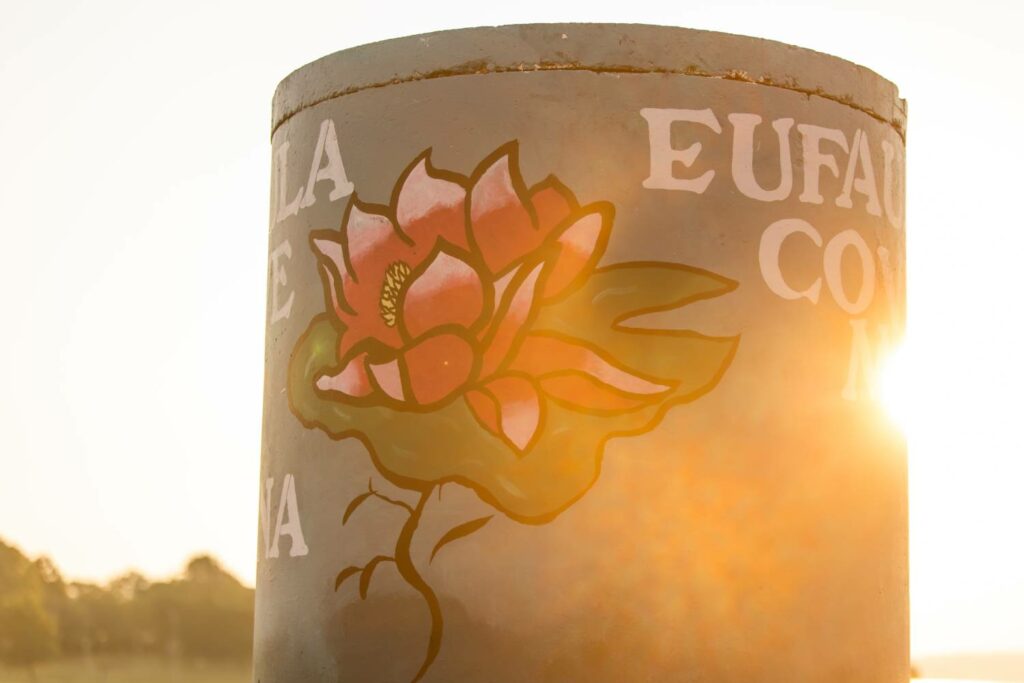Among the many reasons we love Lake Eufaula is its rich history. The lake is named after Eufaula, a town nearby, a name taken after the Creek Nation’s chief Eufaula. The lake also holds the distinction of being the largest lake in Oklahoma, made by constructing a dam across the Canadian River.
Completed in 1964, the dam was dedicated by Lyndon B. Johnson, creating Lake Eufaula, which covers 102,500 acres. The project was part of a larger effort to develop new water resources in the region.
Why was Eufaula Dam built?
Congress approved the construction of the Eufaula Dam to provide flood control, water supply, navigation, and hydroelectric power generation to the area. Built from concrete and earthen embankment, the dam is 3,200 feet long and 114 feet high, boasting three turbines and a capacity of 90 megawatts. The turbines allow the federal government to provide low-cost power to the area.
Connection to Native American History
Before it became a lake, the area was home to several Native American tribes who lived there for hundreds of years. Tribes of this region included the Muscogee Creek Nation, Choctaw Nation, and Cherokee Nation. Most of the 600-mile shoreline of Lake Eufaula lies within the boundaries of the old Creek Nation, with part of the southern portion in the old Choctaw Nation. The Creek Nation occupied the area of what is now the lake, until they were forcibly removed from the area in the early 1830s, after which they were forced to move westward on the Trail of Tears.
Many reminders of this area’s colorful history–Native American life, outlaw gangs, and Civil War battles–remain for visitors to see. The Battle of Honey Springs, the largest and most important of the battles fought during the Civil War in Oklahoma, took place July 17, 1863, on a site about 3 1/2 miles northeast of Checotah.
Transformation into a Massive Reservoir
Not only does Lake Eufaula have a rich and complex history with the Native American population, its creation made it more than a source of water for surrounding communities. The lake has become an incredibly popular recreation spot amongst day trip visitors, anglers, water sports fanatics, and busy families. Boating enthusiasts will also find marinas located around the lake that offer boat rentals, launch ramps, and other amenities.
Fun Facts About Lake Eufaula
As well as its rich Native American history and its reputation as a recreational hotspot, Lake Eufaula also has some interesting facts to share with you!
Lake Eufaula Was a Hideout for Some Pretty Famous Outlaws!
Lake Eufaula has a prevalent history of outlaws including Jesse James, Frank Jame, and Belle Starr who is buried on the southeast side, near the dam.
Rumors of Buried Gold!
Rumor has it that Lake Eufaula hosts buried troves of gold in the area. Spanish conquistadors were said to have planned a search for the treasures, but they never followed through.
North Fork Town
Close to the intersection of the California and Texas roads was North Fork Town. The Creek Tribe founded this town, and it became an important meeting place for intertribal council meetings. The Five Civilized Tribes uprooted from the southeastern U.S. met there because of its centralized location within the five nations of those tribes.
North Fork Town’s location was once considered the crossroads of the Creek Nation. The locale was also close to where the Spanish expeditions crossed the Canadian Rivers in the 1600s in search of gold and silver.
A new train depot that was built a few miles west eventually took the merchants from North Fork Town, and the town became history. The state of Oklahoma decided to build Lake Eufaula over North Fork Town, making it an underwater ghost town.
Standing Rock
One of the most famous landmarks of the area also vanished beneath the waters of Lake Eufaula. Standing Rock, which stood 63 feet above the waters of the Canadian River five miles east of Eufaula, was noted as a fishing spot by early-day settlers.
During the early days of Spanish exploration, Standing Rock was recorded in papers. Some believed the Spanish symbols carved on the rock pointed to buried treasure. Captain Bonneville also mentioned the rock in notes from his 1830 expedition to Fort Gibson.
Lake Eufaula Has Much to Offer
From its start as home to the Creek Nation to its development into the beautiful reservoir that we know today, we love Lake Eufaula. Learn more about its history by going to museums and interpretive centers around the lake, or enjoy the surrounding natural beauty. Take a day hike, play a round of golf, catch your limit of crappie, bass, or catfish, or hit the lake on a kayak or paddleboard; life here is an adventure!
Whether you are looking for a lake house or a relaxing getaway here, contact the Porches and Pastures team to find the perfect fit!




